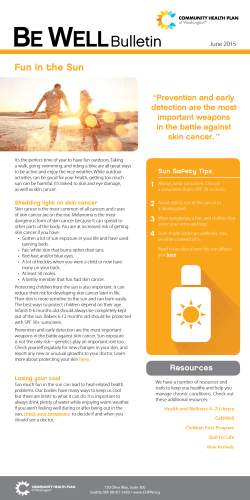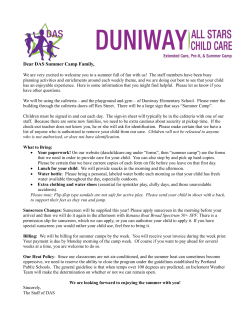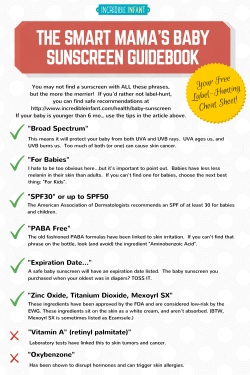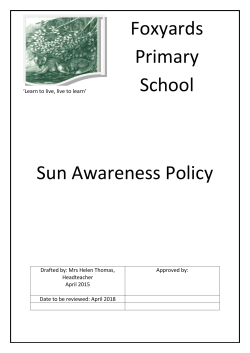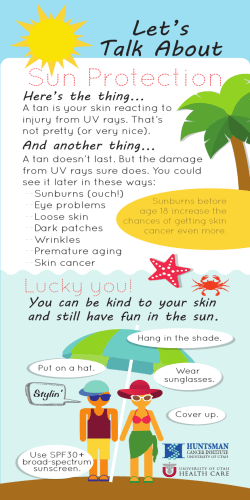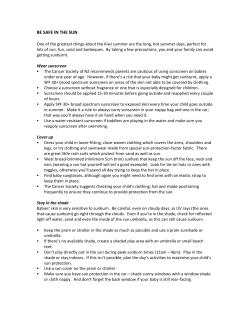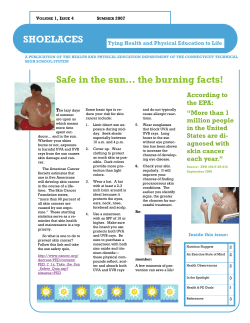
Sunscreen Information - Princeton Nassau Pediatrics
www.princetonnassaupediatrics.com SUN SAFETY What's the best way to protect my child in the sun? Follow these simple rules to protect your family from sunburns now and from skin cancer later in life. • When possible, dress yourself and your kids in cool, comfortable clothing that covers the body, like lightweight cotton pants, long-sleeved shirts, and hats. • Wear a hat or cap with a brim that faces forward to shield the face. • Limit your sun exposure between 10:00 am and 4:00 pm, when UV rays are strongest. • Wear sunglasses with at least 99% UV protection (look for child-sized sunglasses with UV protection for your child). • Set a good example. You can be the best teacher by practicing sun protection yourself. Teach all members of your family how to protect their skin and eyes. Sunscreen Sunscreen can help protect the skin from sunburn and some skin cancers, but only if used correctly. Keep in mind that sunscreen should be used for sun protection, not as a reason to stay in the sun longer. How to Pick Sunscreen • • Use a sunscreen that says “broad-spectrum” on the label - that means it will screen out both UVB and UVA rays. Use a sunscreen with an SPF (sun protection factor) of at least 30. Sunscreen Choices • • • Look for these ingredients when choosing a sunscreen. These agents protect against both UVA and UVB rays. Any one of these 3 ingredients are fine: Avobenzone (Parsol 1789), Titanium Dioxide, Zinc Oxide. Children with sensitive skin or eczema should choose a physical sunblock containing only Titanium Dioxide or Zinc Oxide. Some examples are: Bull Frog; Blue Lizard; Vanicream; Neutrogena Sensitive Skin, WaterBabies-Pure and Simple Sunscreens with Avobenzone: Some examples are: Neutrogena UltraSheer, Coppertone WaterBabies Lotion Sunscreen for Babies • • • For babies younger than 6 months. Keep babies younger than 6 months out of direct sunlight when possible. Find shade under a tree, umbrella, or the stroller canopy. If sun exposure is unavoidable, use sunscreen on small areas of the body, such as the face and the backs of the hands. For babies older than 6 months. Apply to all areas of the body, but be careful around the eyes. If your baby rubs sunscreen into her eyes, wipe the eyes and hands clean with a damp cloth. If the sunscreen irritates her skin, try a different brand or try a sunscreen stick or sunscreen or sunblock with titanium dioxide or zinc oxide. If a rash develops, talk with your child’s doctor. How to apply sunscreen • • • • Use enough sunscreen to cover all exposed areas, especially the face, nose, ears, feet, and hands and even the backs of the knees. Rub it in well. Apply sunscreen 15 to 30 minutes before going outdoors to give time for the sunscreen to bind and absorb into to the skin. Use sunscreen any time you or your child might sunburn. Remember that you can get sunburn even on cloudy days. Also, UV rays can bounce back from water, sand, snow, and concrete so make sure you’re protected. Reapply sunscreen every 2 hours. Sunscreen wears off after swimming, sweating, or just from soaking into the skin.
© Copyright 2025

